A Very High Resolution View Of Big Beautiful Saturn
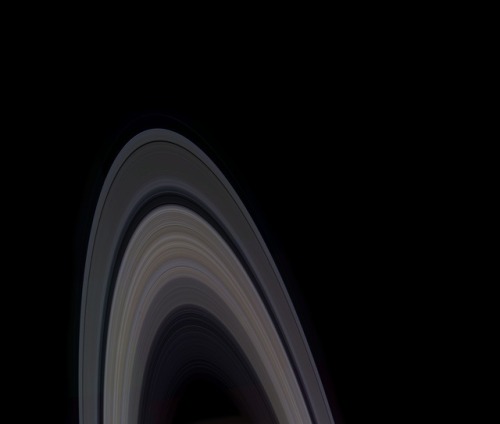
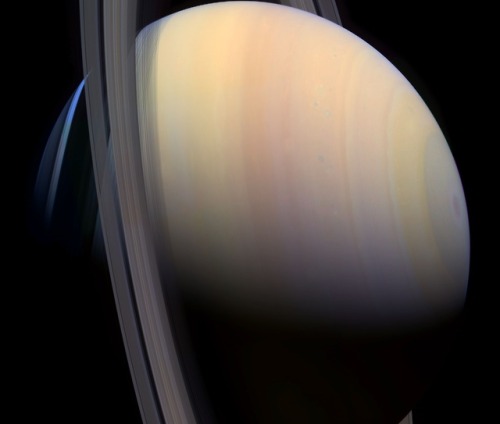
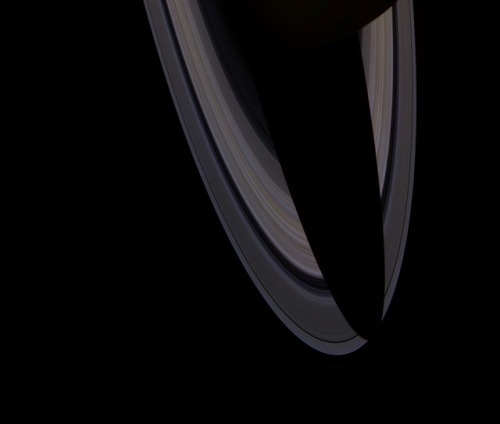
A very high resolution view of big beautiful Saturn
Composition Credit: Mattias Malmer, Image Data: Cassini Imaging Team (NASA)
More Posts from Starlost and Others
sometimes before i go to sleep, i like to get my cellphone, put my headphones on, play city lights by blanche and close my eyes and pretend that i am just floating on a rock in the outer space, all alone in the danger zone

It is so cool to see such photos by beginners made with iPhone and eyepiece: “I know this may not be as good as many other photos but I tried my best with my beginners luck. Equipment : -Skywatcher 8 inch dob (manual) -iphone 7 (held manually) -10 mm eyepiece (super Plossl) Processing : Just photoshopped by -increasing contrast - fixing exposure - balancing whites and blacks Conditions: -very crappy skies (not good transparency) -light pollution: bortle 8-9 (inner city) - Jupiter not at opposition http://ift.tt/2FhOOrZ
seeing the photos from Webb up against photos from Hubble just makes me… I don’t even know like, wow! Look at that!













The qrcodes do take to each planets' nasa site. I learned a lot of each planet while doing this work.
My favorite is Saturn! Which ones yer favorite?
Ten Interesting facts about Mercury
Mercury is the closest planet to the sun. As such, it circles the sun faster than all the other planets, which is why Romans named it after their swift-footed messenger god. He is the god of financial gain, commerce, eloquence, messages, communication (including divination), travelers, boundaries, luck, trickery and thieves; he also serves as the guide of souls to the underworld

Like Venus, Mercury orbits the Sun within Earth’s orbit as an inferior planet, and never exceeds 28° away from the Sun. When viewed from Earth, this proximity to the Sun means the planet can only be seen near the western or eastern horizon during the early evening or early morning. At this time it may appear as a bright star-like object, but is often far more difficult to observe than Venus. The planet telescopically displays the complete range of phases, similar to Venus and the Moon, as it moves in its inner orbit relative to Earth, which reoccurs over the so-called synodic period approximately every 116 days.

Mercury’s axis has the smallest tilt of any of the Solar System’s planets (about 1⁄30 degree). Its orbital eccentricity is the largest of all known planets in the Solar System; at perihelion, Mercury’s distance from the Sun is only about two-thirds (or 66%) of its distance at aphelion.

Its orbital period around the Sun of 87.97 days is the shortest of all the planets in the Solar System. A sidereal day (the period of rotation) lasts about 58.7 Earth days.

Mercury’s surface appears heavily cratered and is similar in appearance to the Moon’s, indicating that it has been geologically inactive for billions of years. Having almost no atmosphere to retain heat, it has surface temperatures that vary diurnally more than on any other planet in the Solar System, ranging from 100 K (−173 °C; −280 °F) at night to 700 K (427 °C; 800 °F) during the day across the equatorial regions. The polar regions are constantly below 180 K (−93 °C; −136 °F). The planet has no known natural satellites.

Unlike many other planets which “self-heal” through natural geological processes, the surface of Mercury is covered in craters. These are caused by numerous encounters with asteroids and comets. Most Mercurian craters are named after famous writers and artists. Any crater larger than 250 kilometres in diameter is referred to as a Basin.

The largest known crater is Caloris Basin, with a diameter of 1,550 km. The impact that created the Caloris Basin was so powerful that it caused lava eruptions and left a concentric ring over 2 km tall surrounding the impact crater.
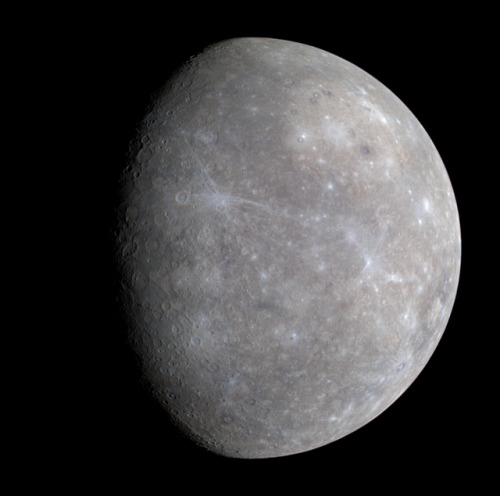
Two spacecraft have visited Mercury: Mariner 10 flew by in 1974 and 1975; and MESSENGER, launched in 2004, orbited Mercury over 4,000 times in four years before exhausting its fuel and crashing into the planet’s surface on April 30, 2015.

It is the smallest planet in the Solar System, with an equatorial radius of 2,439.7 kilometres (1,516.0 mi). Mercury is also smaller—albeit more massive—than the largestnatural satellites in the Solar System, Ganymede and Titan.

As if Mercury isn’t small enough, it not only shrank in its past but is continuing to shrink today. The tiny planet is made up of a single continental plate over a cooling iron core. As the core cools, it solidifies, reducing the planet’s volume and causing it to shrink. The process crumpled the surface, creating lobe-shaped scarps or cliffs, some hundreds of miles long and soaring up to a mile high, as well as Mercury’s “Great Valley,” which at about 620 miles long, 250 miles wide and 2 miles deep (1,000 by 400 by 3.2 km) is larger than Arizona’s famous Grand Canyon and deeper than the Great Rift Valley in East Africa.

The first telescopic observations of Mercury were made by Galileo in the early 17th century. Although he observed phases when he looked at Venus, his telescope was not powerful enough to see the phases of Mercury.
source 1
source 2
source 3
images: Joseph Brimacombe, NASA/JPL, Wikimedia Commons

lionsinthezoo.com

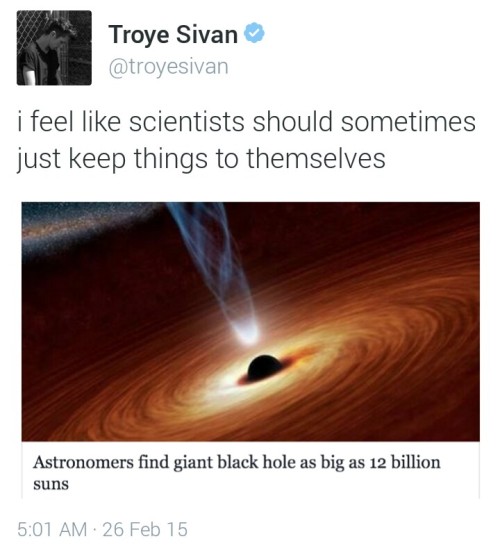

-
 urlilpony liked this · 2 weeks ago
urlilpony liked this · 2 weeks ago -
 loveupeaceinknownyeseen liked this · 2 weeks ago
loveupeaceinknownyeseen liked this · 2 weeks ago -
 coffeemoonstarslove liked this · 3 months ago
coffeemoonstarslove liked this · 3 months ago -
 profitelttanous liked this · 3 months ago
profitelttanous liked this · 3 months ago -
 sophisticatedexuberance reblogged this · 4 months ago
sophisticatedexuberance reblogged this · 4 months ago -
 sophisticatedexuberance liked this · 4 months ago
sophisticatedexuberance liked this · 4 months ago -
 sas-nart reblogged this · 5 months ago
sas-nart reblogged this · 5 months ago -
 prjulioca liked this · 5 months ago
prjulioca liked this · 5 months ago -
 acreshome77088 liked this · 5 months ago
acreshome77088 liked this · 5 months ago -
 ishizzle liked this · 6 months ago
ishizzle liked this · 6 months ago -
 annallzs0 liked this · 6 months ago
annallzs0 liked this · 6 months ago -
 manoelwilliam reblogged this · 7 months ago
manoelwilliam reblogged this · 7 months ago -
 crossdresserica liked this · 7 months ago
crossdresserica liked this · 7 months ago -
 peard reblogged this · 7 months ago
peard reblogged this · 7 months ago -
 seekbeautyinthemundane reblogged this · 7 months ago
seekbeautyinthemundane reblogged this · 7 months ago -
 chestercheeta reblogged this · 7 months ago
chestercheeta reblogged this · 7 months ago -
 justadaddybear reblogged this · 7 months ago
justadaddybear reblogged this · 7 months ago -
 justadaddybear liked this · 7 months ago
justadaddybear liked this · 7 months ago -
 charlesdclimer reblogged this · 7 months ago
charlesdclimer reblogged this · 7 months ago -
 charlesdclimer liked this · 7 months ago
charlesdclimer liked this · 7 months ago -
 underzemilkyway reblogged this · 7 months ago
underzemilkyway reblogged this · 7 months ago -
 richiwshr liked this · 9 months ago
richiwshr liked this · 9 months ago -
 booselwawa reblogged this · 10 months ago
booselwawa reblogged this · 10 months ago -
 secatz reblogged this · 1 year ago
secatz reblogged this · 1 year ago -
 screamingwombatgirl reblogged this · 1 year ago
screamingwombatgirl reblogged this · 1 year ago -
 screamingwombatgirl liked this · 1 year ago
screamingwombatgirl liked this · 1 year ago -
 noisilyuniquedream liked this · 1 year ago
noisilyuniquedream liked this · 1 year ago -
 flamingstairway reblogged this · 1 year ago
flamingstairway reblogged this · 1 year ago -
 flamingstairway liked this · 1 year ago
flamingstairway liked this · 1 year ago -
 dotglobal liked this · 1 year ago
dotglobal liked this · 1 year ago -
 superfan44 liked this · 1 year ago
superfan44 liked this · 1 year ago -
 733s reblogged this · 1 year ago
733s reblogged this · 1 year ago -
 mateocmpr liked this · 1 year ago
mateocmpr liked this · 1 year ago -
 innerdestinybear reblogged this · 1 year ago
innerdestinybear reblogged this · 1 year ago -
 clearbluewatersblog liked this · 1 year ago
clearbluewatersblog liked this · 1 year ago -
 k1ll3rqu33n liked this · 1 year ago
k1ll3rqu33n liked this · 1 year ago -
 lunarmoth07 reblogged this · 1 year ago
lunarmoth07 reblogged this · 1 year ago -
 pleasuredhands reblogged this · 1 year ago
pleasuredhands reblogged this · 1 year ago -
 w0lfw0man reblogged this · 1 year ago
w0lfw0man reblogged this · 1 year ago -
 thedovetailinginterests reblogged this · 1 year ago
thedovetailinginterests reblogged this · 1 year ago -
 adifferentfeeling reblogged this · 1 year ago
adifferentfeeling reblogged this · 1 year ago -
 thedovetailinginterests liked this · 1 year ago
thedovetailinginterests liked this · 1 year ago

andrei, he/him, 21, made this at 14 when i was a space nerd but i never fully grew out of that phase so,,,,..,hubble telescope + alien life + exoplanet + sci fi nerd
245 posts
